![]()
![]()
![]()
Use LEFT and RIGHT arrow keys to navigate between flashcards;
Use UP and DOWN arrow keys to flip the card;
H to show hint;
A reads text to speech;
77 Cards in this Set
- Front
- Back
- 3rd side (hint)
|
Tissues |
Groups of cells that are similar in structure and perform a similar function |
|
|
|
Histology |
The study of tissues |
|
|
|
Nervous tissue |
Controls Internal communication Found in the brain, spinal cord, and nerves |
|
|
|
Muscle tissue |
Movement Contracts to cause movement |
|
|
|
Skeletal muscle tissue |
Muscles attached to bones Voluntary |
|
|
|
Cardiac tissue |
Muscles of the heart Involuntary |
|
|
|
Smooth muscle |
Muscles of walls of hollow organs Involuntary |
|
|
|
Epithelial tissue |
COVERS Forms boundaries between different environment Found in lining of digestive tract and skin surface (epidermis) |
|
|
|
Basic functions on epithelial tissue |
Protect secrets absorbs filters |
|
|
|
Connective tissue |
SUPPORTS Supports, protect, and binds other tissues together Found in bones, tendons, & fat *most abundant tissue in the body* |
|
|
|
Types of epithelial tissue (2) |
Covering and lining epithelium Glandular epithelial |
|
|
|
Covering / lining epithelium |
• forms outer layer of skin • lines the open cavities of urogenital, digestive, and respitory sytms • covers walls and organs of closed ventral body cavity |
|
|
|
Glandular epithelium |
Comes together forming clumps Glands of the body |
|
|
|
Epithelial tissue functions |
Protection absorption Filtration Excretion Secretion Sensory reception |
6 |
|
|
Polarity |
Two surfaces that differ in structure and function Apical-Basal polarity |
Special characteristics of epithelial tissue |
|
|
Apical surface |
Upper free surface exposed to bodies exterior or cavity of an internal organ |
|
|
|
Basal surface |
Internal surface Under the apical surface |
|
|
|
Special characteristics of epithelium |
Polarity Specialized contacts Supported by connective tissue Avascular but innervated Ability to regenerate |
5 |
|
|
Microvilli |
Smallest Finger-like extensions of the plasma membrane that increase surface area |
|
|
|
Cilia |
LARGER Hairlike projections that moves substances along the surface |
|
|
|
Basal lamina |
Selective filter adjacent (kinda under) to the basal surface Consist mostly of glycoproteins and some collagen fibers Acts as a selective filter that determines what what diffuses from the underlying connective tissue Acts as scaffolding for wound repair |
|
|
|
Specialized Contacts |
Epithelial cells fit closely together to form a continuous sheet |
Special characteristics of epithelium |
|
|
Tight junctions |
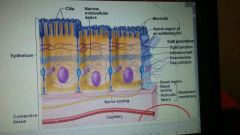
Fuses the membranes of adjacent cells together |
Epithelial cells |
|
|
Desmosomes |
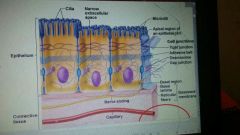
Keep cells anchored Keeps polarity |
|
|
|
Reticular lamina |
Deep to basal lamina Extracellular connective tissue Basal lamina + reticular lamina= basement membrane |
|
|
|
Avascular but innervated |
Epithelial tissue is avascular (no blood vessels) but it is innervated (contains nerve fibers). Cells are nourished by diffusion |
Special characteristic of epithelium |
|
|
Simple epithelia |
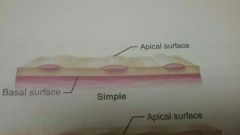
Single layer of cells Found where fibration, secretion, or absorption is needed |
|
|
|
Stratified epithelia |

2 or more layers of cells Found where protection is needed because of wear and tear |
|
|
|
Squamous cells |
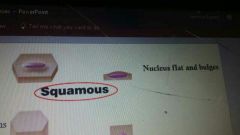
Flat and scale like Nucleus is flat and bulgding |
|
|
|
Cuboidal cell |
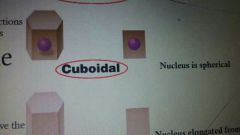
Box like As tall as they are wide Nucleus is spherical |
|
|
|
Columnar cell |
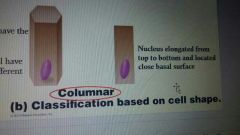
Tall and column shaped Nuclues is elongated and xlose to basal surface |
|
|

Simple squamous epithelium |
Functions ▪allows materials to pass by diffusion ▪secretes lubricating substances in serosae Locations ▪air sacs of lungs ▪blood vessels |

In kidneyes |
|
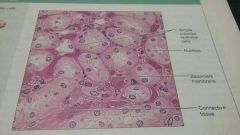
Simple cuboidal epithelium |
Function ▪secretion ▪absorption Location ▪kidney tubules ▪ovary surface
|
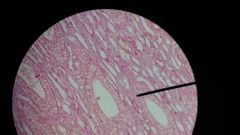
|
|
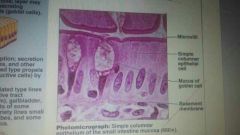
Simple columnar epithelia |
*may contain goblet cells* High absorbtion areas have microvili (small intestine) Funtions ▪absorption ▪secretion of mucus Location ▪digestive tract ▪gallbladder ▪uterine tubes |
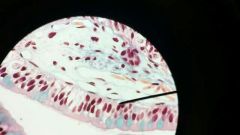
|
|
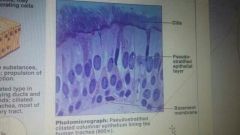
Pseudostratified columnar epithelia |
*single layer of cells* *differ in heights, some haven't reached free surface*
Function ▪secrete substances (mucus) ▪propel mucus Location ▪male sperm duct (nonciliated type) ▪trachea (ciliated type) |
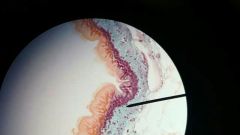
In trachea |
|
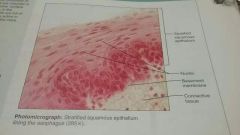
Stratified squamous epithelium |
Thick membrane composed of several layers Surface cells are squamous Basal cells are cuboidal or columnar Function ▪protect underlying tissues (in areas subjected to abrasion) Location ▪skin (keratinized) ▪mouth (nonkeratinized) |
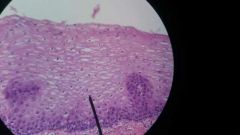
|
|
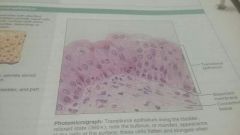
Transitional epithelia |
Surface cells squamous Basal cells cuboidal or columnar *Cells can change (transition) their shape Function ▪Stretch rapidly Location ▪bladder ▪line the ureters |

|
|
|
Goblet cell |
Individual cell that produces mucus Found in respitory and intestinal tract |
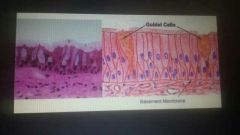
|
|
|
Gland |
Structure composed of one or more cells that make and secrete a particular product |
|
|
|
Secretion |
Aqueous fluid that contains proteins what can also contain lipids or steroids |
|
|
|
Endocrine glands |
"Ductless glands" ▪produce hormones ▪Internally secreting (excocytosis) ▪hormones enter the blood ▪are usually multicellular |
|
|
|
Exocrine glands |
▪Exernally secreting ▪Secrete their products onto body surfaces (skin) or into body cavities ▪produce mucus, sweat, oil |
|
|
|
Unicellular exocrine glands |
▪mucous cells ▪goblet cells *scattered within epithelial sheets* |
|
|
|
Multicellular exocrine gland |
2 basic parts ▪duct ▪secretary unit |
|
|
|
Simple glands |

Unbranched duct |
|
|
|
Compound glands |
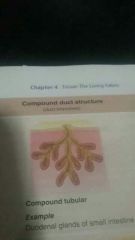
Branched bucts |
|
|
|
Tubular gland |
Secretary cells form tubes |
|
|
|
Alveolae gland |

if secretary cells form small flask like sacs |
|
|
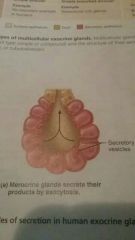
Merocrine glands |
Secrete their product by exocytosis Cells are not altered in any way Examples: pacreas, sweat glands, salivary glands |
|
|

Holocrine glands |
Accumulate product within them until they rupture Exapmple: sebaceous gland |
|
|
|
Major connective tissue classes |
▪connective tissue proper (mature connective tissue) ▪cartilage ▪bone ▪blood |
4 |
|
|
Mahor connective tissue functions |
▪ binding and supporting ▪protecting ▪insulating ▪storing reserve fuel ▪transporting substances within the body |
5 |
|
|
Characteristics of connective tissue |
▪ common origin (all connective tissue arise from mesenchyme) ▪ degrees of vascularity ▪ extracellular Matrix ( the nonliving parts of the tissue that separates the living cells) * connective tissue is largely nonliving* |
|
|
|
Structural elements of connective tissue |
▪ ground ▪ fibers ▪ cells |
3 |
|
|
Ground substance |
The material that fills the space between the cells and contains fibers Compostion of GS: interstitial fluid, cell adhesion proteins, and proteoglycans. |
Connective tissue |
|
|
Connective tissue fibers |
Collagen fibers (thickest and strongest), elastic fibers (stretch and are coiled), reticular fibers (short and fine fobers |
3 types |
|
|
Loose connective tissues |
▪ areolar ▪adipose ▪reticular |
|
|
|
Dense connective tissue |
▪ dense regular ▪ dense irregular ▪ elastic |
|
|
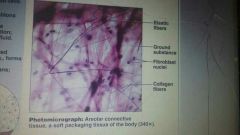
Areolar connective tissue |
▪ has a gel-like matrix ▪ has all three fiber types ▪its cells are: fibroblasts, macrophages, mast cells, some white blood cells Loaction ▪under epithelia ▪ surrounding capillaries Function ▪ supporting and binding other tissues ▪ defending against infections |
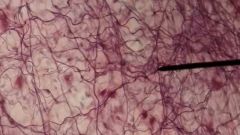
Loose connective tissue |
|
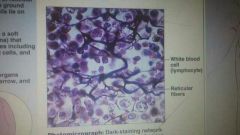
Reticular connective tissue |
Has reticular fibers and lymphocytes (white blood cells) Locations ▪lymph nodes ▪bone marrow Function ▪ form stroma that supports free blood cells |
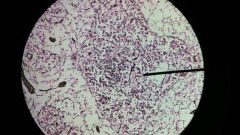
Loose connective tissue |
|
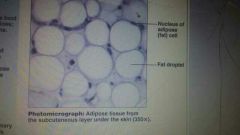
Adipose connective tissue |
▪matrix is areolar ▪ nucleus is pushed to the side because of large fat droplets Location ▪abdomen ▪breast Function ▪store energy (fat) ▪insulation |
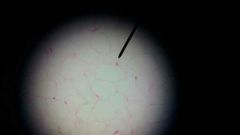
Loose connective tissue |
|
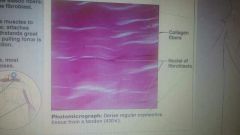
Dense regular connective tissue |
▪parallel collagen fibers ▪major cell tu6pe is fibroblast Locations ▪tendons ▪ligaments Function ▪attach muscle to bone ▪resist tension |
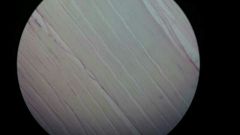
Dense connective tissue |
|
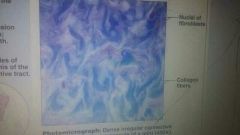
Dense irregular connective tissue |
▪ irregularly arranged collagen fibers ▪ major cell type is fibroblast Location ▪dermis of skin ▪submucosa of digestive tract Function ▪ resist tension in many directions ▪ provide structural strength |
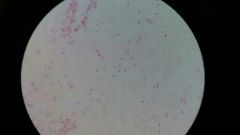
Dense connective tissue |
|

Elastic connective tissue |
Dense regular connective tissue with a high proportion of elastic fibers Location ▪ aorta ▪bronchial tube walls Functions ▪recoil ▪stretch |
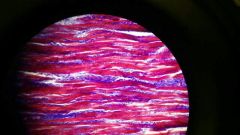
Dense connective tissue |
|
|
Cartilage |
- composition is between dense connective tissue and Bone - resistant to tension and compression - no nerve connection and is avascular |
|
|
|
Types of cartilage |
▪hyaline cartilage ▪elastic cartilage ▪fibrocartilage |
3 |
|
|
Lacunae |
A small space in cartilage or bone occupied by cells |
|
|
|
Perichondrium |
Connevtive tissue layer that surrounds cartilage. Provides caryilage with nutritikn via diffusion |
Cartilage |
|
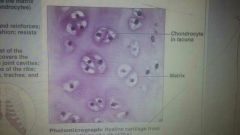
Hyaline cartilage |
*most abundant cartilage in the body* *contains collagen fibers* *cell type is chondrocytes* Function ▪ supports and reinforces ▪ resist compressive stress Location ▪nose ▪trachea |
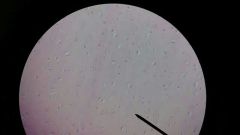
|
|
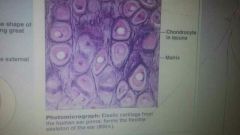
Elastic cartilage |

-has more elastic fobers than hyaline cartilage -where strengyh and elasticity is required Location ▪ear ▪epiglottis Function ▪ maintain shape while allowing flexibility |
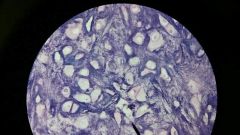
|
|
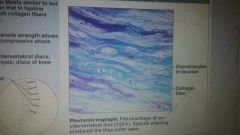
Fibrocartilage |
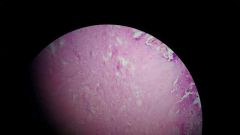
-alternating rows of chondrocytes and thick collagen fiber Location ▪intervertebral disc ▪knee Function ▪tensile strength ▪absorb compressive shock |
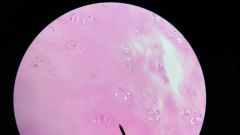
|
|
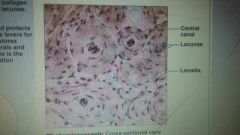
Bone (osseous tissue) |
Supports and protects body structures -Has a matrix, but is harder due to calcium salts Osteoblasts Location ▪bones Function ▪support and protect by enclosing |
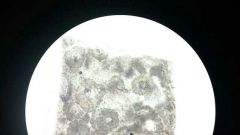
|
|

|
Osseous tissue Center is 'central canal' Smaller dots are lacunae |
|
|
|
Blood |
*connective tissue* Function *transport respitory gases and waste Location Within blood vessels |
|
|
|
Cutaneous membrane |
Skin |
|
|
|
Mucous membranes |
Line body cavities that are open to the exterior |
|
|
|
Serous membrane |
Line body cavities that are closed to the exterior |
|

